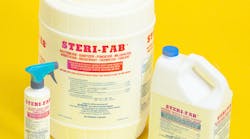In the cold drizzle of a late February afternoon in Milwaukee, Rob Norton smoked a cigarette as he waited for the westbound 51 bus back home. Norton said he’s avoided the influenza strains spreading around the city through a flu shot during the fall and regular squirts of hand sanitizer tucked into his carryall.
Norton said it’s all about guarding against the bugs he’s caught in the past, especially when out in public settings like the bus.
“I’ve picked up colds and stuff, but not the flu. You can pick it up anywhere, though, you just can’t tell,” he said.
Riders, transit operators and third-party providers have had to step up their defenses during what the Centers for Disease Control and Prevention (CDC) has deemed an “elevated” level of influenza across the country. That includes taking lessons from recent wildfires that scorched California and deadly epidemics that plagued Dallas.
“You don’t have to pass a health test to board the bus. We don’t have the same slogan as the Statue of Liberty, but the effect is the same,” said John Haley, Director of Transit, San Francisco Municipal Transportation Authority.
‘High Activity’
As of the week ending Feb. 10, the CDC reported preliminary numbers of outpatient visits for “influenza-like illness” (ILI) at 7.5 percent, more than three times the national baseline. Every state in the CDC’s 10 coverage “regions” reported at or above baseline reports for the flu. Broken down by state, 43 states, plus New York City, Puerto Rico and the District of Columbia, ranked as having experienced “high ILI activity” through its most recent tallies in mid-February.
Positive samples of two strains of the flu — influenza A and B — appeared to have peaked by the last week of January. However, as influenza A has taken a dip in recent weeks, there has been a counter-trend in the rise of positive results for influenza B. By another measure, this flu season hit approximately 60 hospitalizations per 100,000 people, which nearly matches the previous peak of about 65 per 100,000 in 2014-15 — with 12 weeks still remaining in this season.
The CDC maintains a big push for flu vaccinations. In addition, its “every day” prevention techniques include calls for symptomatic or sick people to stay home and to “increase distance” from people in public settings, such as mass transit.
Outside Opportunities
By its very purpose, mass transit brings people together. And few places bring more people together on muni buses, light rail, street cars and cable cars than the San Francisco MTA. With 700,000 trips per day, there are plenty of opportunities for “lessons” from disruptions and public health crises, Haley said.
For one, wildfires across the bay from San Francisco in fall 2017 led to “detrimental impacts” on air quality across the region. Along with water, the authority gave out masks, and soon found out that “not all masks are created equal,” Haley said. Those paper masks with filters were found to be far more effective than those without. The filter masks have continued to give operators peace of mind and protection during this year’s flu season, predicted to be one of the worst ever in California.
Another outside practice now helping the flu fight in San Francisco are mobile cleaning crews. MTA has increased its fleet of vans stocked with cleaning supplies that respond to big human messes that happen among its fleet. With up to three in service during rush hour, the mobile crews not only keep vehicles out of service for shorter periods, they’ve also boosted the mentality of cleanliness for riders and operators.
“[Mobile cleaning crews] were not done in particular response to the flu, but they certainly help with any type of airborne or contagious disease,” Haley said.
In Dallas, Morgan Lyons, V.P. of External Communications with Dallas Area Rapid Transit (DART), said DART officials in many ways continue the communications push they started in 2009 with a flu pandemic and amplified in 2014 when a rail station outside of a hospital became “ground zero for Ebola in the United States.” In those communications — on Facebook, to the media and in the employee intranet — Lyons said consistent reminders help cut through the din and instill good habits like hand washing, covering up coughs and sneezes, and staying home when under the weather. The conversation also keeps operators in the loop on risks and realities during outbreaks large and less so.
“It becomes part of the daily routine” to talk about public health best practices," Lyons said. He later added: “The messaging changes year in and year out. Get your flu shot because every strain is different. And we’ve certainly learned that this year.”
As of early February, there were no signs yet of mass days lost to illness among the 3,700 employees of DART or “any change in passenger activity and daily ridership,” Lyons said. (That as the flu had caused the closure of two school districts north of Dallas.) However, with little predictability over the flu, DART backs up its communications with access for staff to flu shots, gloves and masks.
Into Your Own Hands
Along with constant communications and a few new techniques, agencies and operators still might have to take cleaning into their own hands.
Drew Kerr, Public Relations Specialist for Metro Transit in Minneapolis, noted that, in addition to free flu vaccines in the fall, his agency has pushed the use of sanitary wipes for drivers to clean off the areas around their seats. And, as of earlier this month, Metro Transit hadn’t seen “any noticeable impact on absenteeism or ridership,” according to Kerr.
Sterifab is a Yonkers-based provider of antimicrobial liquid to cleaning companies hired by transit agencies, as well as other facilities like schools, dorms and hospitals. Eric Bryan, a Sterifab sales V.P. for 25 years, said health scares like this year’s flu can seem “daunting” to agencies like subway or bus operators who want to ensure healthy rides for employees and passengers.
Bryan said it was too early in this season to register any uptick in sales from the flu. He has heard of bus drivers who grab their own spray bottle for a once-over on seats and steering wheels.
Overall, on the prevention front, his company was stressing regular cleaning by transit operators in conjunction with basics shared by public health outlets.
“The nature of it is that you don’t know,” he said of airborne, contagious illnesses.

Justin Kern
Justin Kern is a writer and nonprofit marketing manager who lives in Milwaukee with his wife and cats.



